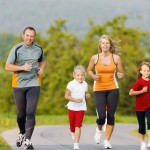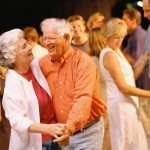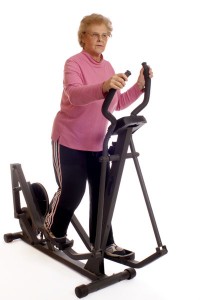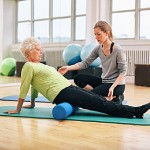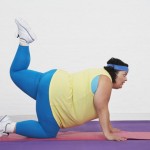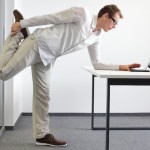STAYING YOUNG AS YOU AGE
Some astounding Findings
Dr. Samuel Hahnemann, Homeopathy’s founder, recognized already in the early 1800’s that certain diseases cannot be cured if they are suffered by people who are continually lacking of exercise or open air. This kind of ill-health disappears spontaneously under an improved lifestyle!
Sloth, or being lazy is more than just one of the seven capital sins, it is actually deadly: Approx. 5 million people world-wide die annually because they don’t get enough exercise. The good news is: it’s not so hard to stay healthy or get back to health. Because when we move our bodies, they produce myokines. Messengers that burn fat, and protect the brain from dementia and the diseases of civilization such as cancer and diabetes.
Exercise is vital to staying healthy. This is why the fun of games and sports should be awakened as early as childhood. The deficits found even in adolescents are quite alarming
When people stay active in old age, their bodies produce increasing amounts of antioxidants which protect the cells from free radicals
We have devices all around us that lighten our manual workload, and take away the effort of going up the stairs or just simply walking. We think this is progress. But it is becoming more and more obvious that this type “progress” comes with a high price: It is costing us our health! The funny thing is that fundamentally we are still at the same level physically and psychologically as our ancestors from the stone age were. Back then, however, people walked distances of 20 to 30 km per day looking for food. Today, we barely cover 600 to 1,000 meters on average. They walked barefoot, thereby automatically massaging the foot reflexology zones that stimulate the inner organs. But the invention of shoes put an end to this and led to a weakening of the muscular system of the feet. The result: Flat feet, fallen arches and splay feet are practically normal now.
Our ancestors from the stone age did not know chairs – and had no problems with their hip joints or deep vein thromboses, which develop as a result of sitting too long. The Canadian Physical Activity Guidelines recommend that to achieve health benefits, adults should get at least 2-1/2 hours of moderate-to-vigorous physical exercise per week, made up of intervals lasting at least 10 minutes. That works out to just a little more than 20 minutes per day. But only one in five adults actually do get this amount of exercise.
Swedish researchers have found that sitting for only four hours will cause bad reactions in our bodies. That’s when an enzyme involved in fat reduction stops working properly and the risk of cardiovascular problems and diabetes increases.
It seems that while we used to spend our time writing and thinking, we now prefer to just sit and control. Our arms’ range of motion is limited to the width of steering wheels, computer keyboards or dining plates. And the leisurely grabbing of remote control units, beer glasses or potato chips does not widen it considerably.
A typical evening pastime of many families: Sitting in front of the TV
The situation with adolescents is particularly concerning. One study showed that physical activity drops substantially between the ages of 11 and 15. Only 20 percent of boys and 14 percent of girls achieve the amount of activity recommended by experts world-wide.
More and more automation protects our musculoskeletal system. Our metabolism slows down and so does our mind
Physical laziness leads to stupidity
We mutated from the active person to the sitting person. The “homo sapiens” became a “homo sedens”. And the increasing lack of exercise means trouble for our mental health too: Laziness leads to stupidity. Because: When you are lacking exercise, you are at an increased risk of developing Alzheimer’s, Parkinson’s Disease or Depression, according to newer studies. A long-term study conducted in Sweden with 1,500 men and women showed, however, that in middle-aged people who exercised at least twice per week, the risk of Alzheimer’s decreased by 60 percent.
It was proven, by the way, too, that laziness leads to stupidity, by a study that showed that our intelligence quotient is not constant, as previously assumed. Surprisingly: It changes, among others, with physical activity. A ten-day-long strict bedrest, for example, lowered the IQ by 15 %.
Apart from the most recent past, in the history of humans, people were always more active than rested, and the brain has adjusted. It needs physical stimulation to function normally – idleness slows its metabolism. Experiments with runners have shown that intensive exercise releases the body’s own endorphins which suppress pain and produce pleasant feelings, up to the euphoric “runner’s high”.
But more happens in our brains when we engage in intense physical activity. When a group of young, healthy men were training on a training bike, it was found that this not only increased the circulation in their legs, but in their brains as well. New blood vessels formed in the cortex, the hippocampus and cerebellum, and the formation of nerve cells was stimulated too. This is because there are a number of hormone-like messengers that are produced by the active muscles.
The discovery of Myokines
When the cells of our muscles are moved, they produce the so-called myokines. Messengers, which positively influence all other organs. The discovery was actually made by a Danish researcher. The word “Myokine” is derived from the Greek “mys” for muscle and “kinos” for movement – because it is only when the muscles are moved that they produce these highly effective and health promoting messengers.
According to Dr. Pedersen, we do not produce enough myokines if we don’t exercise our muscles. As we exercise the muscles, myokines are produced which influence all other organs. They target fat and burn precisely the fat sitting in the wrong places. They keep the vessels and the liver healthy. Myokines even affect the brain and protect against dementia.
Muscles, when they are moved, release numerous of health-promoting messengers. This is why they are a very important metabolic organ
While it is assumed that there are about 400 different myokines, only a small number of them has been researched to date. Among these is the BDNF (brain-derived neurotrophic factor) which is so useful for our intellectual capacity. It stimulates the build-up of new nerve cells and synapse connections and has even been referred to as the “fertilizer for the brain”.
Why Seniors should dance
This led researches to get seniors enrolled in dancing classes. In a German study, 25 participants aged 60 to 94 were asked to dance for an hour per week over a period of six months. The foundation was a program developed specifically for seniors. In contrast to the control group which didn’t dance, the participants showed remarkable improvements in the areas of cognition, reaction, motor skills, sensory skills, balance and life style.
Dancing is especially suitable to older people. Because not only does it benefit mental fitness, it is simply fun
The music with its rhythm, social and emotional interaction and the cognitive challenge of learning new step formations makes dancing stand out against other types of physical activity. It is more fun, and this is very important. It has already been proven on animals that physical activity provides for increased growth of nerve cells. This has a positive effect on the mind and memory. But it is important that this motor activity be enjoyed and taken up voluntarily. Because that’s what stimulates the release of the “feel good hormone” Serotonin, which, encourages the formation of new nerve cells in the brain during physical activity, according to some studies.
A treadmill or an elliptical machine have proven helpful for psychological problems as well as prevention of dementia
Running helps with depression
Psychologists agree that psychological problems such as fears or depression can be relieved by activity. How you go about it depends on your individual preference, whether you use a treadmill or go hiking with a group of others to conquer your fears, you will find that exercising regularly is often more effective than taking medicine. You need about 30 minutes of it per day.
Basically, it doesn’t matter what the problem is, once you start moving at the physical level, then this will help you in dealing with the emotional problem too.
How to turn back the clock of life
The positive effect on the brain is but one of the advantages of regular physical activity. It reduces, as proven by numerous epidemiological studies, the risk of cardiovascular disease, stroke, diabetes, obesity, breast and colon cancers. And it prolongs life: 15 minutes alone of daily exercise increases life expectancy by three years – according to findings based on the health data of more than 400,000 Taiwanese.
Apart from life expectancy, exercise also improves the quality of life. Aerobic activity of medium intensity, practiced regularly, can turn the clock of life back by 12 years. This according to a study published in the British Journal of Sports Medicine.
If you want to stay young, you need to move. It is irrelevant what kind of activity you choose
And a study at Boston University came to the result that we do not age chronologically, but biologically. If we can maintain the body functions then the biological aging process can be delayed. And so the saying “use it (your muscles, your brain) or loose it” holds true here too.
There is yet another study from a German university, which examined 310 active and inactive people aged 20 to 70. It showed that the active 60 to 70 year-olds were just as fit as the inactive 20 to 30 year-olds.
Exercise can stop cancer and diabetes
The prophylactic, disease prevention significance of physical activity has been without dispute for quite some time. The notion that it is helpful in acute disease also is more recent. Up until not too long ago, cancer or cardiovascular patients were prescribed relaxation and rest. This has changed. Now physical activity is considered therapeutic and it can be dosed similarly to medication. Patients with stable coronary heart disease can increase their life expectancy by beginning to engage in sports. It is true that the body shrinks each muscle that is not being moved and challenged, particularly the heart. Space research has shown that subjects who were put on bedrest for three weeks and not allowed to move, were severely affected: Their oxygen intake decreased by 28 percent, cardiac minute output by 25 percent and the heart muscle itself shrank by 11 percent.
As far as cancer is concerned, we know today that physical activity can prolong the lives of breast cancer patients and decrease the risk of relapse. A study undertaken at the Women’s Hospital in Boston with 3,000 women showed that those who spent three to four hours of walking per week had a 50 percent lower risk of dying from breast cancer. This result is also due to a strengthened immune system on the one hand, and the myokines produced by the active muscle which evidently inhibit the growth of tumor cells in the female breast, on the other.
Doing Sports can often take the place of medication
Sports should take on an important role in the treatment of cancer, alongside chemo therapy, radiation and surgery. But not only here. In other areas too, for example in diabetes, it makes sense to engage in physical activity: Exercise can help regulate metabolic processes, thereby replacing medications in many cases and most importantly it can improve a patient’s prognosis.
Let’s take the example of a 52-year-old real estate agent diagnosed with type 2 diabetes. He never did any sports before. It was only after he was diagnosed with high blood pressure as well, that he decided to change his life style. Just couldn’t see himself taking beta blockers on top of the insulin. He then started a combined weight and stamina training, 30 minutes three times per week. Eight months later, he had a medical check-up with the surprising result that not only his blood pressure went back to normal, but his blood sugar levels did too, making the insulin shots obsolete. This is not an isolated case. In fact, experience shows that type 2 diabetes is curable in many cases: through changes in the diet, weight reduction and muscle training. Whereby the latter plays an essential role.
A study in the Netherlands with 5,000 patients was undertaken to understand the relationship between diet and diabetes. The surprising result was that exercise had a greater impact on the disease process than did the diet. It became apparent that physically active diabetics had a 38 % lower risk of death. Even moderate exercise will give some protection. It does make sense to become active when the symptoms are there already.
The explanation: Only the muscle which has been moved absorbs glucose, thereby lowering blood sugar levels and insulin requirements. Furthermore, myokines such as irisin see to it that the body cells react better to insulin and that fat burning is stimulated. Swedish biologists have found that irisin levels double in test persons after only 10 weeks of stamina training. Also, fat-splitting enzymes are increasingly activated during exercise and fat transportation to the liver is improved. Blood fat levels are reduced and bad LDL cholesterol decreases.
Consistent physical activity often has more of an effect on diabetics than does the diet
Why blood vessels and bones stay young
And that’s not all. Exercising increases the production of the body’s own antioxidants, which catch harmful free radicals and prevent oxidative stress. The increased blood flow leads to the formation of new capillaries and activates enzymes which produce nitrogen monoxide, and that in turn promotes elasticity of the blood vessels. This causes blood pressure to decrease and the risk of arteriosclerosis decreases as well. Furthermore, some of the myokines act as anti-inflammatory, others encourage bone formation or promote well-being. All in all we can say: Exercise converts our skeletal muscles into an endogenous health factory.
The positive effects in short are: – more power stations (mitochondria), – more capillaries in the trained muscles, – relative protection against heart attacks, – reduction of the vital oxygen requirements of the heart while increasing the oxygen supply at the same time, – improvement in the blood’s flow quality, – health-related, positive changes in fat metabolism, – and in the hormonal regulation of the metabolism, as well as a – positive influence on blood pressure, – on body weight and – the immune system. At the same time, an increased sense of well-being.
Every step counts! Find something that you enjoy doing and which suits your condition
It doesn’t come down to peak performance
The only question left to answer in lieu of the abundance of benefits: How to start, what type, what intensity and how long to exercise for to get the most reward?
It’s sometimes better to use the term movement rather than exercise. Because that’s what it’s all about. Going for a walk or using the stairs are not really considered exercise, but depending on a person’s condition, the act of walking slowly can be an outstanding exercise already. The work-out needs to the suited to the individual’s capabilities for sure.
Sports medicine specialists recommend in particular aerobic stamina training such as walking, hiking, using the stairs, jogging, cross-country skiing, bicycling or swimming.
This should be done at least two to three times per week to the extent of burning at least 2,000 extra calories in that week. It is healthiest for the heart, the circulation and the brain if you train at a pulse frequency that is at 50 % of your personal peak performance. Every person can figure out easily what that means for themselves. There is a formula that has been used for 50 years and which is still valid today: 180 minus the number of years of age. That’s how you calculate your optimal pulse rate when exercising.
Do it moderately, but regularly – that’s the Name of the Game
It is up to each individual to decide how much to expect of themselves. But it is clear that the health benefit gets greater the more you move. It doesn’t come down to peak performance. The effect of exercise is calculated based on the product of intensity plus duration. A brisk walk over a longer period of time can be just as effective as jogging for a short period of time. This was also confirmed by a U.S. study that compared the data of 33,000 joggers with 16,000 walkers. It became apparent that the risk of hypertension and coronary heart diseases lessens – regardless of whether you jog or walk. The determining factor is simply the amount of energy you consume, and it doesn’t matter how you get there. Once you start sweating, you are on the right track.
There is more stress on the joints when jogging as opposed to walking – especially if you are overweight. Walking is our natural way of forward movement, we are anatomically optimized for this. And so there is nothing wrong with starting here.
Walking or hiking or Nordic Walking (which has the advantage that we are using the muscles of the arms and upper body too) are so healthy that we should not forgo their benefits. They’re as good for the immune system as they are for creativity, because often our best ideas come when we are walking.
As mentioned before: It is important not to overdo it when exercising. It is not about competition with anybody. If you overdo it and end up exhausted you will damage your health. Take it from Sebastian Kneipp, who summarized the basic principle already 125 years ago: Inactivity makes you weaker, moderate activity makes you stronger, overexertion is harmful. If you want to be really safe, get a sports medical exam and have your respiratory volume or your blood levels of lactic acid tested to develop an individualized training plan.
Why it is so bad to sit for long
But we have to be clear on one thing: If you sit for long periods of time during the day, say 10 to 12 hours, you cannot simply make up for that damage by doing an evening workout or jogging. Long phases of sitting harbor risks. If you work in an office, you should get up every 45 minutes and move around. Walk, use the stairs, do some stretching exercises. Or, if it’s possible, get a standing desk and work at that.
It is easy to integrate physical activity in your daily office work: Use the stairs, stand up when phoning or make an exercise out of getting files
In an Australian study, 4,800 adults were equipped with an activity measuring device which registered how often the participants sat or moved. The result was then compared with their blood sugar and blood fat levels, as well as hip measurement. Not surprisingly, the results got worse the longer they sat. But it was also proven that even small interruptions in sitting had a positive effect. And this is comforting to know.
It is therefore not such a good idea to sit still in the office like we were taught to do in school, and which our kids still have to do today. Change positions often. Motion to the front, to the back, alternate putting more weight on the right side of your buttocks with the left side, tilt your pelvis forward and backward, move around, do some exercises – whatever. And lift your buttocks off your seat as often as you can. Phone somebody while standing up, bring messages to your colleagues personally rather than e-mailing them. It doesn’t matter what you do to interrupt the marathon sitting – everything is helpful.
And so, being active really is medicine, as research has shown. What’s more, it’s cheap – and it even comes with a fun factor!
I hope you found this article interesting and motivating and wish you all the best for the busy fall season ahead. Don’t forget to schedule in some time for yourself each day to do something fun!
In health,
Irene Schwens Hom, DHMHS, C.Tran.
Owner / HomeopathRegistration #15241
K-W HOMEOPATHIC MEDICINE
……………………….………ANDWELLNESS CLINIC
751 King Street West, Suite 310
Kitchener, ON N2G 1E5
T (519) 603-0505
F (519) 653-0506
“The physician’s highest and only calling
is to make the sick healthy, to cure, as it is called”
— Dr. Samuel Hahnemann, §1, Organon of the Medical Art —
